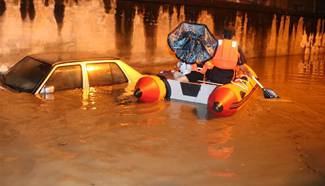
BEIJING, June 16, 2016 (Xinhua) -- Photo taken on June 15, 2016 shows the Chinese and English versions of the white paper elaborating on the development of China's BeiDou Navigation Satellite System (BDS). The Chinese government on June 16, 2016 released the white paper about the development of the BDS, which is independently developed and operated by China. (Xinhua/Li He)
BEIJING, June 16 (Xinhua) -- The State Council Information Office of the People's Republic of China published a white paper titled "China's BeiDou Navigation Satellite System" on Thursday.
Following is the full text of the white paper:
China's BeiDou Navigation Satellite System
The State Council Information Office of the People's Republic of China
June 2016
Contents
Preface
I. Goals and Principles of Development
II. Development of the BDS
III. Reliable and Safe Satellite Navigation Services
IV. BDS Application and Industrial Development
V. International Cooperation and Exchanges
Conclusion
Preface
The BeiDou Navigation Satellite System (hereinafter referred to as the BDS) has been independently constructed and operated by China with an eye to the needs of the country's national security and economic and social development. As a space infrastructure of national significance, the BDS provides all-time, all-weather and high-accuracy positioning, navigation and timing services to global users.
In the late 20th century, China started to explore a path to develop a navigation satellite system suitable for its national conditions, and gradually formulated a three-step strategy of development: to complete the construction of the BDS-1 and provide services to the whole country by the end of 2000; to complete the construction of the BDS-2 and provide services to the Asia-Pacific region by the end of 2012; and to complete the construction of the BDS and provide services worldwide around 2020.
Along with the development of the BDS project and service ability, related products have been widely applied in communication and transportation, marine fisheries, hydrological monitoring, weather forecasting, surveying, mapping and geographic information, forest fire prevention, time synchronization for communication systems, power dispatching, disaster mitigation and relief, emergency search and rescue, and other fields. These products are gradually penetrating every aspect of social production and people's life, injecting new vitality into the global economy and social development.
Navigation satellite systems are public resources shared by the whole globe, and multi-system compatibility and interoperability has become a trend. China applies the principle that "The BDS is developed by China, and dedicated to the world" to serve the development of the Silk Road Economic Belt and the 21st Century Maritime Silk Road ("Belt and Road Initiative" for short), and actively pushes forward international cooperation related to the BDS. As the BDS joins hands with other navigation satellite systems, China will work with all other countries, regions and international organizations to promote global satellite navigation development and make the BDS better serve the world and benefit mankind.
I. Goals and Principles of Development
China lays store by the construction of the BDS, ranking it one of its national key technical projects that supports its innovative development strategy.
(I) Goals of Development
Building a world-class navigation satellite system to meet the needs of the country's national security as well as economic and social development, and providing continuous, stable and reliable services for global users; developing BDS-related industries to support China's economic and social development, as well as improvement of people' s living standards; and enhancing international cooperation to share the fruits of development in the field of satellite navigation, increasing the comprehensive application benefits of Global Navigation Satellite System (GNSS).
(II) Principles of Development
China upholds the principles of "independence, openness, compatibility and gradualness" in the BDS construction and development.
- By "independence," it means to uphold independent construction, development and operation of the BDS, and acquire the capability to independently provide satellite navigation services to global users.
- By "openness," it means to provide open satellite navigation services free of charge, and encourage all-scale, multilevel and high-quality international cooperation and exchange.
- By "compatibility," it means to enhance BDS compatibility and interoperability with other navigation satellite systems, and encourage international cooperation and exchanges, so as to provide better services to users.
- By "gradualness," it means to carry out the BDS project step by step, enhance BDS service performance, and boost the development of satellite navigation industry in a comprehensive, coordinated and sustainable manner.
II. Development of the BDS
Based on its national conditions, China has independently developed the BDS step by step with constant improvement.
(I) Three-Step Strategy of Development
- The first step is to construct the BDS-1 (also known as BeiDou Navigation Satellite Demonstration System). The project was started in 1994, and the system was completed and put into operation in 2000 with the launching of two Geostationary Earth Orbit (GEO) satellites. With an active-positioning scheme, the system provided users in China with positioning, timing, wide-area differential and short message communication services. The third GEO satellite was launched in 2003, which further enhanced the system's performance.
- The second step is to construct the BDS-2. The project was started in 2004, and by the end of 2012 a total of 14 satellites - 5 GEO satellites, 5 Inclined Geosynchronous Satellite Orbit (IGSO) satellites and 4 Medium Earth Orbit (MEO) satellites - had been launched to finish the space constellation deployment. Based on a technical scheme which was compatible with the BDS-1, the BDS-2 added the passive-positioning scheme, and provided users in the Asia-Pacific region with positioning, velocity measurement, timing, wide-area differential and short message communication services.
- The third step is to construct the BDS. The project was started in 2009 to inherit the technical schemes of both active and passive services. The goal is to provide basic services to the countries along the Belt and Road and in neighboring regions by 2018, and to complete the constellation deployment with the launching of 35 satellites by 2020 to provide services to global users.











